Creating, Formatting, and Sorting Swimlanes Levels for Version 7.1
Contents
- 1 Overview
- 2 Microsoft Project, Microsoft Excel, Oracle Primavera P6, and Smartsheet Source Plans
- 3 Swimlane Level Sub-Tab Controls
- 4 Formatting Swimlane Level Headings, Cells, and Borders
- 5 Using Multiple Swimlane Levels with Timeline Layout Charts
- 6 Related Links
Overview
Illustrations used in this article are from OnePager Pro using data from Microsoft Project but the feature's function, controls, and manual edits apply equally to other OnePager editions that import from data sources like Microsoft Excel, Smartsheet, and Oracle Primavera P6.
Swimlanes are provided in OnePager to assist you in organizing your source plan tasks into common groupings for presentations in support of your schedule conversation goals. OnePager supports three (3) swimlane levels that can be created, edited, and hidden in the chart to suit your needs.
Swimlane levels can be established before the creation of chart in the Template Properties form’s distributed with OnePager. You are able to edit these multiple swimlane levels and individual swimlane level cells globally using the Chart Properties form’s Rows/Swimlanes tab. Manual controls are also provided so you can use a combination of manual mouse actions, right-click context menu commands, and features on OnePager’s Home ribbon tool bar tab to edit selected swimlane levels and swimlane level cells.
Chart Properties Form’s Rows/Swimlanes Tab’s Swimlanes Control Group
The focus of this article is on the Swimlanes control group of the Chart Properties form’s Rows/Swimlanes tab as shown below:
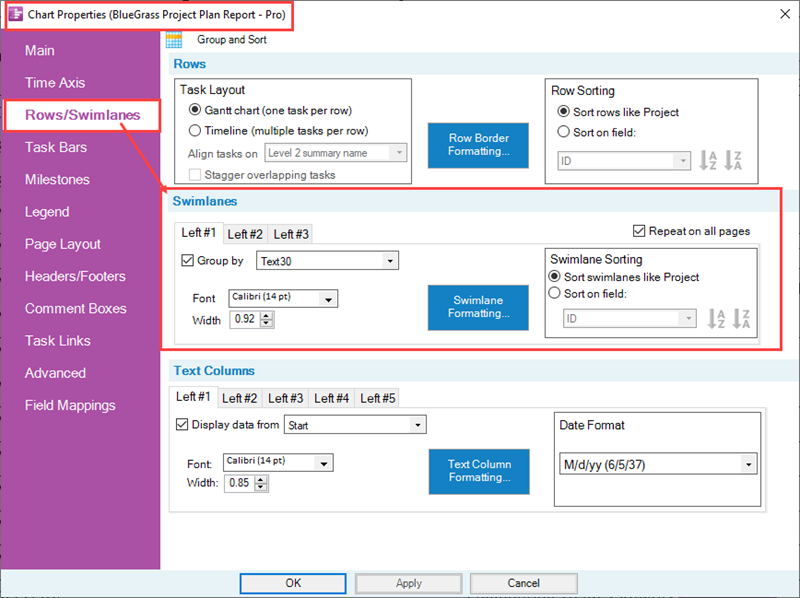
Discussed later in this article is a supporting form, the Swimlane Formatting form, available for each swimlane level. This form is provided to specifically support global editing for swimlane level headings, swimlane level cells, and swimlane borders. The Swimlane Formatting form is accessed by clicking the Swimlane Formatting… button in the Swimlanes control group of the form illustrated above. The Swimlane Formatting form for the left-most swimlane in a chart looks like this:
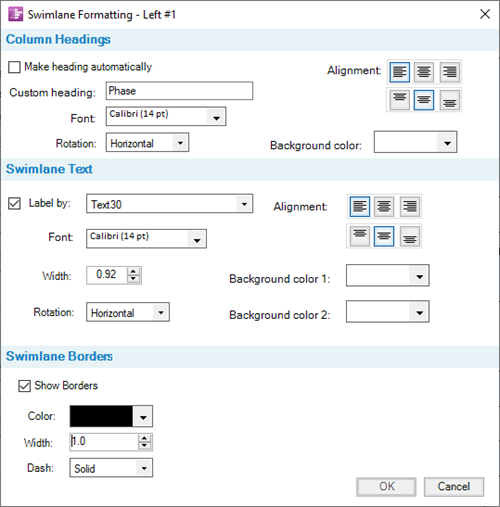
Swimlane Level Nomenclature
In the Swimlanes control group shown in the Chart Properties form’s Rows/Swimlanes tab above, there are three sub-tabs marked Left#1, Left#2, and Left#3. This nomenclature is used to name the three swimlane levels available in OnePager. Previous versions of OnePager supported just one swimlane level. Clicking each of the three sub-tabs shown Chart Properties form’s Rows/Swimlanes tab accesses an identical set of controls for the selected sub-tab. To illustrate this better, consider the portion of a Microsoft Project source plan below annotated with how the various source plan fields are intended for use to make a OnePager Pro chart with three swimlane levels:
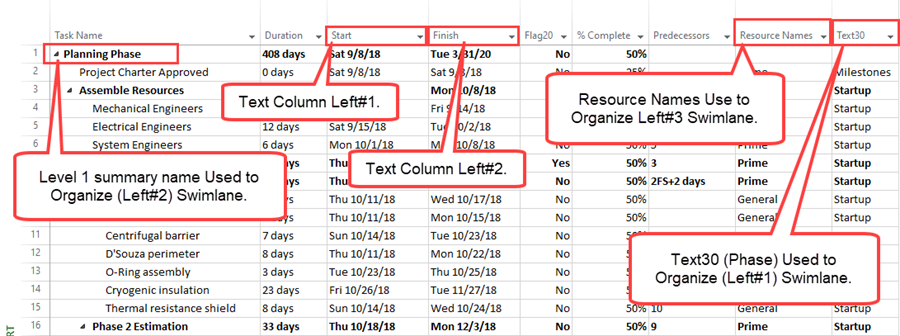
Using the source plan shown above, we can create a sample OnePager chart with three swimlane levels is shown in the illustration below:
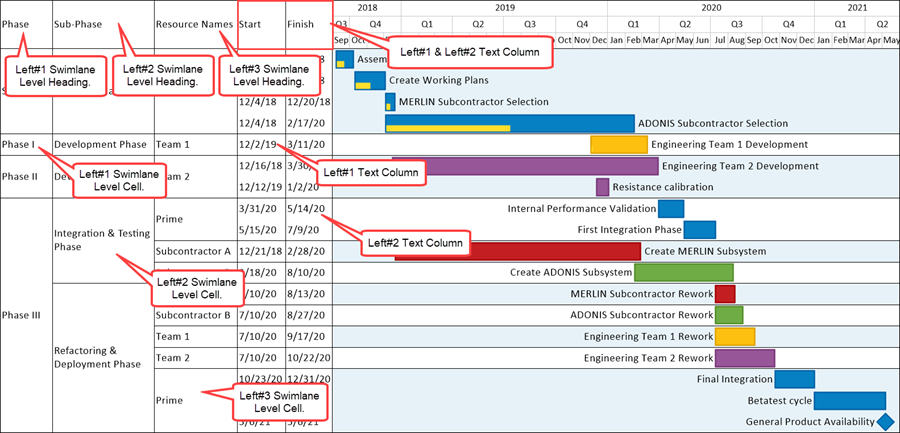
The three swimlane levels are on the far left side of the chart where:
- The Left#1 swimlane level heading is for the project’s Phases
- The Left#2 swimlane level heading is for the project’s Sub-Phases
- The Left#3 swimlane level heading is for the project’s Resource Names.
There are two text columns to the right of the three swimlane levels which are labeled Start for the Left#1 text column and Finish for the Left#2 text column. Swimlane cells are shown below their respective swimlane level headings in the illustration above. This article and related articles use this nomenclature to identify individual swimlane levels and swimlane cells.
Microsoft Project, Microsoft Excel, Oracle Primavera P6, and Smartsheet Source Plans
The Chart Properties form’s Rows/Swimlanes tab are essentially the same for all editions of OnePager . The controls described in this article and the remainder in the series applies to Microsoft Project, Microsoft Excel, Oracle Primavera P6, and Smartsheet imported source plans. Where there are differences between source plans, there is a separate article covering specifically the requirements for using the features.
Swimlane Level Sub-Tab Controls
In this and following sub-sections, it is assumed that you are using a distributed Template or have created a Template that supports either the Gantt chart or Timeline layout chart. Accordingly, it is assumed that an appropriate Template is selected as the starting point.
Since the Gantt chart is the most typical chart organization used in general practice, this portion of the article focuses on how the swimlane level sub-tab controls are used to create Gantt Charts. The Template Properties form’s Rows/Swimlanes tab is identical to the corresponding tab in the Chart Properties form. Illustrations in this article use the Chart Properties form’s Rows/Swimlanes tab.
For a more in depth discussion on how to use the Chart Properties form’s Rows/Swimlanes tab to create and edit Timeline layout charts, please see the sub-section at: Using Multiple Swimlane Levels with Timeline Layout Charts
The article providing comprehensive information on the Rows control group can be found at: Collecting, Formatting, and Sorting Task/Milestones into Rows
The Chart Properties form’s Rows/Swimlanes tab is shown above with the Swimlanes control group highlighted for the discussion that follows:

Before using the above form, we strongly recommend that careful consideration be given to the number of swimlane levels you want to appear in your chart and the source plan field names that you want to associate with each swimlane level. For the purpose of illustration in this article, the three swimlane levels are associated with the following Microsoft Project source plan field names:
- Left#1 is associated with the Microsoft Project Text30 field column and represents the sample project’s Phase.
- Left#2 is associated with the Microsoft Project Level 1 summary name field column and represents the sample project’s Sub-Phase.
- Left#3 is associated with the Microsoft Project Resource Names field column and represents the sample projects Resource Names assigned to each source plan task.
Group by Checkbox
The Group by checkbox, when checked ON, enables the controls in the sub-tab and tells OnePager that you want source plan tasks associated with the source plan field displayed to the right of the checkbox grouped into a swimlane level. When the Grouped by checkbox is checked OFF, the remaining controls in the sub-tab are disabled and that sub-tab’s swimlane level is not shown in the chart. The dropdown window next to the Group by checkbox is a list of source plan fields available for use in defining a swimlane level as shown below:
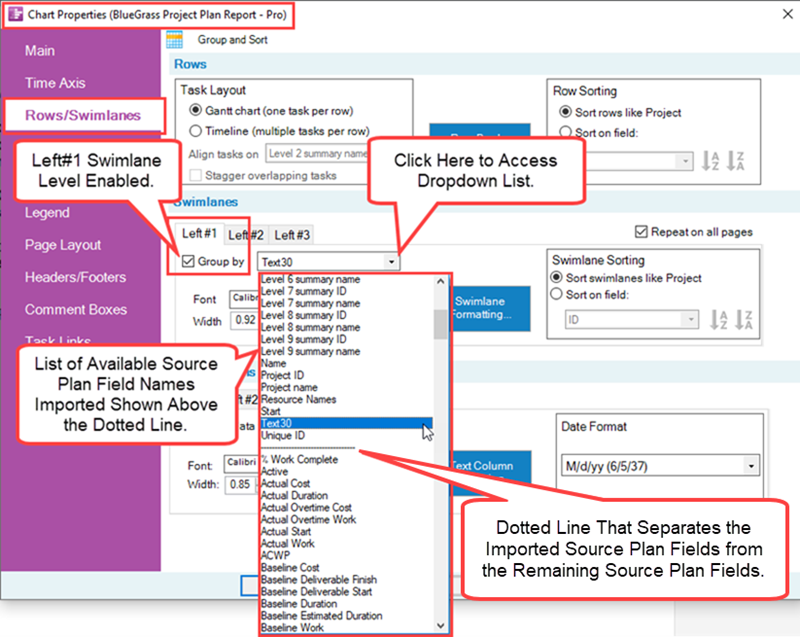
As an example, if we create a chart with just the Left#1 swimlane level defined using the source plan’s Text 30 field with Swimlane Sorting like Project, the chart looks like this:
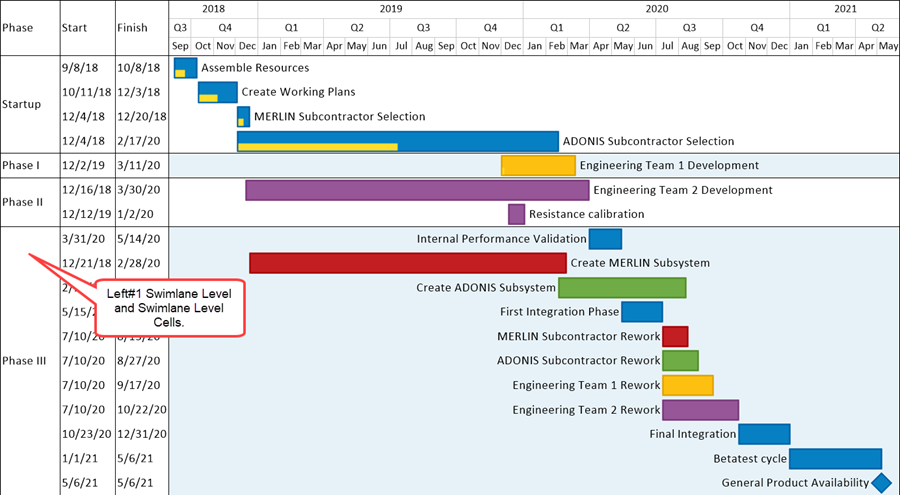
As a further example, if we retain the above Swimlane Sorting, and check the Group by checkboxes ON for the Left#2 and Left#3 swimlane levels, the chart looks like this:
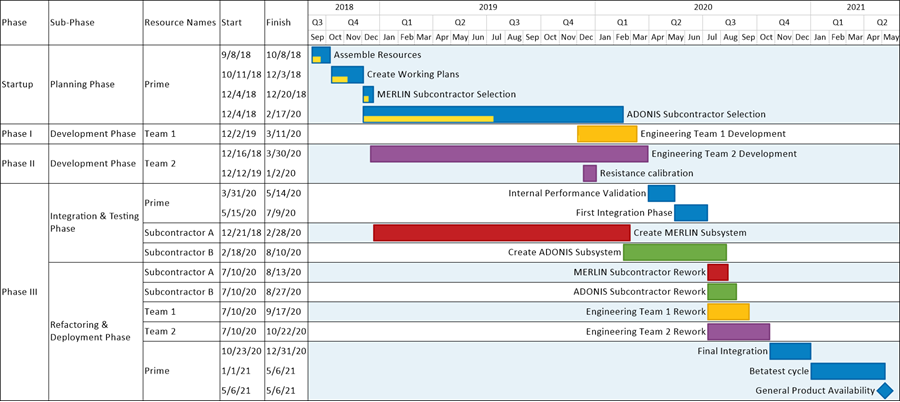
Repeat on all Pages Checkbox Control
There are three other enabled controls in each Swimlanes’ control group’s sub-tabs. The Repeat on all pages checkbox when checked ON, tells OnePager to display the swimlane level on all output media. For more information on controlling output media, please see the articles at: Creating Multi-Page Charts (Portal)
Swimlane Level Text String Font Controls
Clicking the Font dropdown control accesses the standard Font properties form shown here:
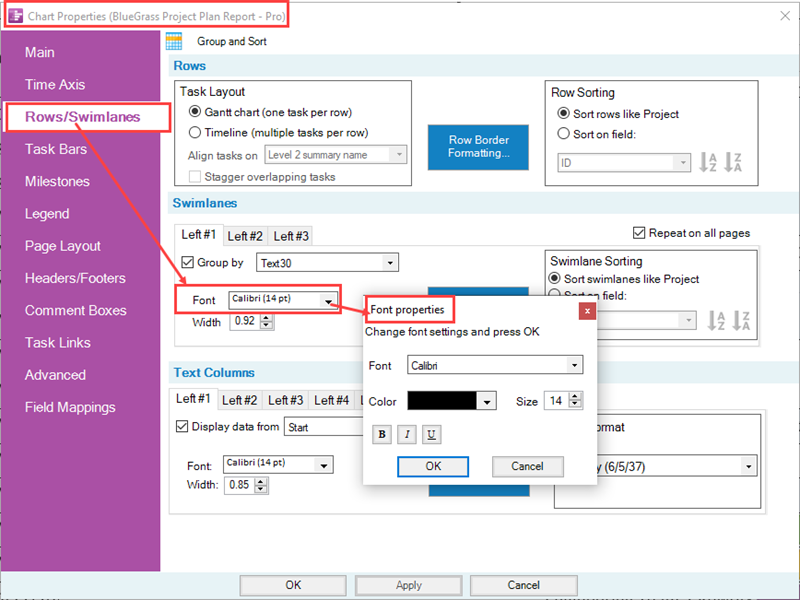
When the Font properties form is accessed for a swimlane level, changes made to any font properties in the form are applied to the swimlane level cells as shown below where the Font properties form is used to change the Left#1 swimlane level cells to the color red:
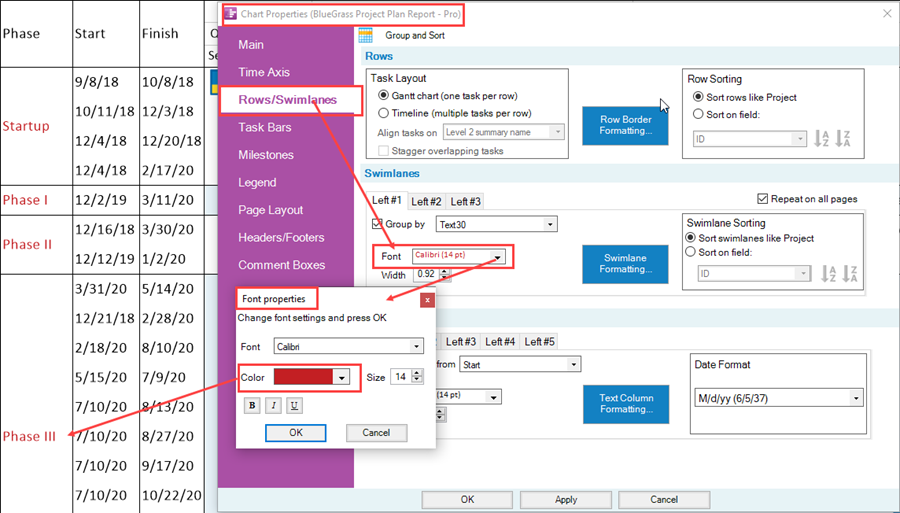
The Font properties form is provided for making global changes to the swimlane level cells in the associated swimlane level. The swimlane level’s heading is not involved as shown above. Using the Font properties form to change the font properties of any swimlane level’s cells applies the change or changes to only the applicable swimlane level. All other swimlane level cells are unchanged.
Swimlane Level Column Width Controls
The Width dial control in the swimlane level sub-tab provides a means of changing the width of the swimlane level’s column in the chart. The Width dial control displays the current swimlane level’s width in either centimeters or inches depending on the Template Properties form being used. By changing the value in the Width dial control you can make the width of the swimlane level’s column in the chart wider or narrower as shown below where the Width dial control’s value is significantly increased:
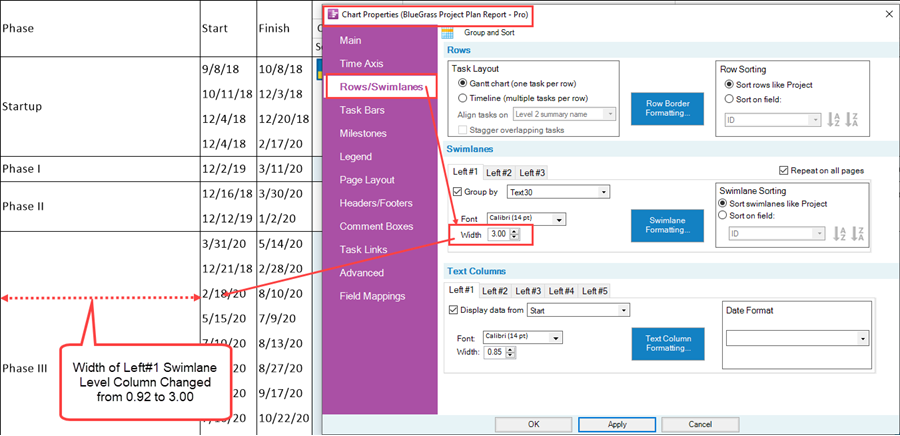
When the Width control is used to change the width of a swimlane level’s column, the swimlane level heading’s width is appropriately changed as well. As with the Font controls, the Width controls apply only to the selected swimlane level and its swimlane level column width. All other swimlane level column widths are not changed.
Swimlane Sorting Sub-Control Group
Each sub-tab in the Chart Properties form’s Rows/Swimlanes tab has a Swimlane Sorting sub-control group as shown below:
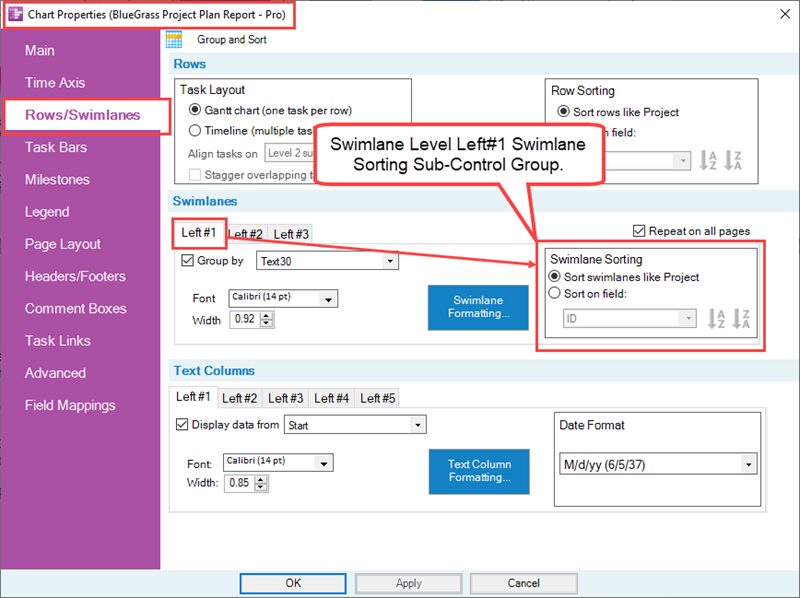
As with the Row Sorting sub-control group for Rows, the Swimlane Sorting sub-control group supports Sorting swimlanes like Microsoft Project, or Sort swimlanes like Excel, or Sort swimlanes like source and sorting swimlanes on a field value. The default option for sorting swimlane levels is the Sort swimlanes like Project or Sort swimlanes like Excel, or Sort swimlanes like source for all three swimlane levels. When the Sort swimlanes like Project radio button is selected, OnePager sorts the specific swimlane levels cells using the Microsoft Project ID field as the key. If you are using Microsoft Excel, Oracle Primavera P6, or Smartsheet source plans as your imported data the concept is the same.
If the Sort on field: radio button is selected, the default field is the ID field and the default sort order is ascending (lowest to highest value). For the Sort on field: option, you can change the field and the order of the sort once the Sort on field: radio button is selected and the related controls are enabled.
Sort Swimlanes – Basic Examples Using Microsoft Project
As a basic example, using only the Left#1 swimlane level, is the chart below showing the single swimlane level and three text columns showing the Start Date, Finish Date, and the ID for each source plan task shown in the chart:
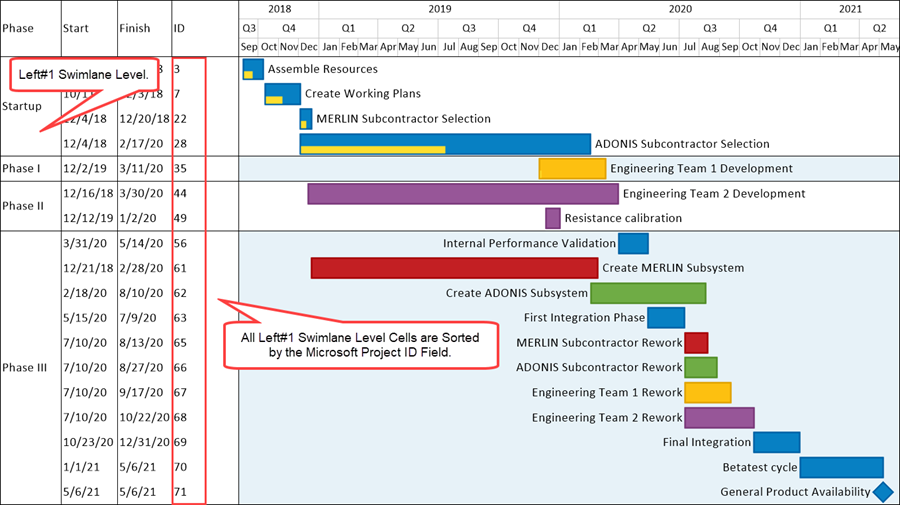
Examining the above chart closely, each set of task bars and their rows are arranged within the Left#1 swimlane level cells in ascending order. For example, the Phase III swimlane level cell in the Left#1 swimlane level starts with ID of 56 at the top and 71 at the bottom of the Phase III swimlane level cell. When the Left#2 swimlane level is added to the above chart and the Sort swimlanes like Project Swimlane Sorting option is preserved, the chart changes to look like this:
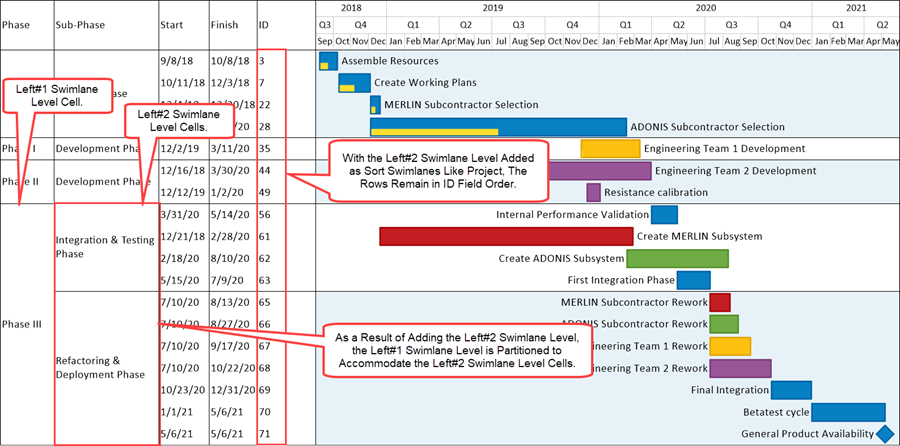
The two charts above have their rows and task bars/milestone symbols in the same order top to bottom so the only difference from adding the Left#2 swimlane level is to achieve an additional level of row grouping and labeling to the rows. Finally, adding the Left#3 swimlane level using the same Swimlane Sorting option, further partitions the rows as shown here:
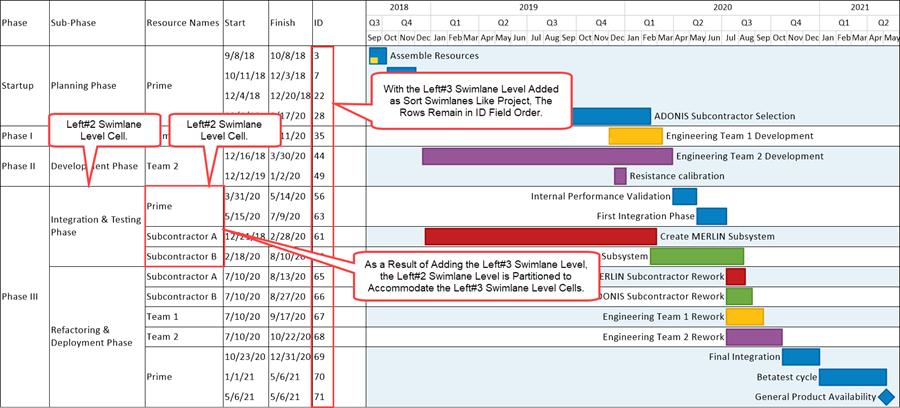
With all three swimlane levels present in the chart and all using the Sort swimlanes like Project option, the rows remain sorted by ID field within each of the three swimlane levels. The benefit for having multiple swimlane levels is that the organization of the task bars/milestone symbols can be easily correlated with their swimlane level membership. This may be useful in schedule discussion presentations where the audience is diverse and has interest in different “levels” of the project. Adding swimlanes and informative text columns can enhance the information content of the chart and help focus an audience’s attention to the specific issues of the schedule presentation.
For more information on Managing Collection of Rows, please see the article at: Collecting, Formatting, and Sorting Task/Milestones into Rows
For more information on Managing Text Columns, please see the article at: Creating and Formatting Text Columns
Sort on Field:
When the Sort on field: radio button is clicked, the window below the radio button and the two directional buttons are enabled. The default setting for Microsoft Project source plans is the ID field.
For Microsoft Excel source plans, OnePager Express attempts to find a source plan field in the Microsoft Excel file that is a numeric sequential field.
- 1) Accordingly, we recommend OnePager Express users add a sequential numeric field to your Microsoft Excel source plans specifically for this purpose.
- 2) Users typically add a numeric field called Task ID and populate it in their Microsoft Excel source plans sequentially.
For OnePager using Oracle Primavera P6 source plan imported data, OnePager uses the Activity ID as the default field in most distributed Template Properties forms. When Smartsheet source plan imported data are used, OnePager uses the Task ID as the default field in most distributed Template Properties forms.
When the Sort on field: radio button is clicked, the enabled sub-control groups looks like this with the window’s dropdown selected:
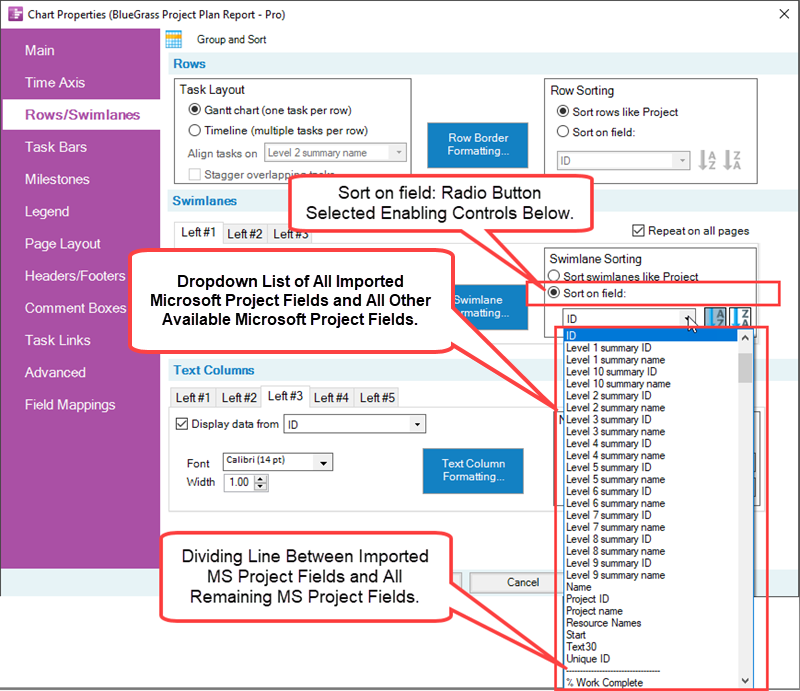
The dropdown list shown above is divided into two parts with the fields above the dotted line being those fields specifically imported into OnePager because these fields are mentioned as settings in the Template Properties or Chart Properties form. Below the dotted line, you have the option to scroll down and select any other of the remaining source plan fields that OnePager has access.
For a list of all the Microsoft source plan fields that OnePager Pro has access, please see the article at: Microsoft Project Fields Available to OnePager Pro
For a list of all Oracle Primavera P6 XML and XER source plan columns that OnePager has access, please see the article at: Oracle Primavera P6 Columns Available to OnePager
To the immediate right of the dropdown window are two directional buttons that specify the direction of the Sort on field: operation: (1) Top to Bottom (Lowest to Highest) – A to Z or (2) Bottom to Top (Highest to Lowest) – Z to A as shown below:
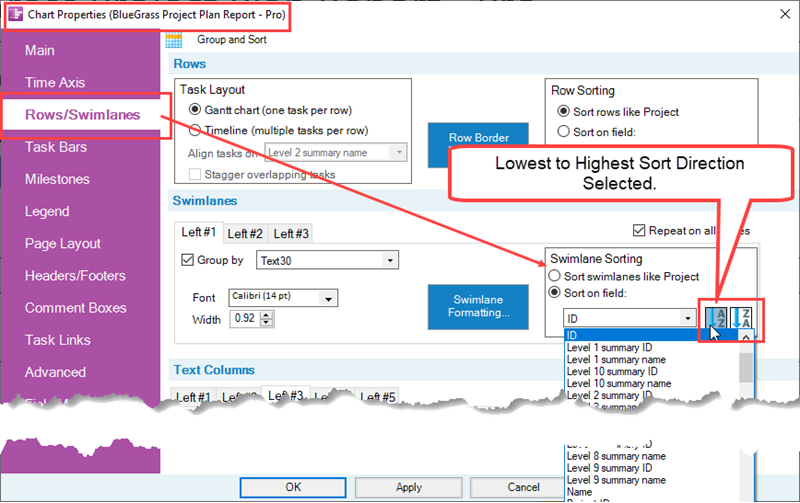
The default setting is Top to Bottom (Lowest to Highest) – A to Z. Numeric, date, and Boolean source plan fields are processed in a similar way as alphabetical fields. As discussed above, the Sort on field: option is conditional on the definition of one or more multiple swimlane levels in the chart. Sorting of rows has an influence on the results when multiple swimlane levels are present at the lowest swimlane level. That is, sorting of rows is performed within the lowest swimlane level defined for the chart where the Left#3 swimlane level is the lowest swimlane level in a three swimlane level chart. As a simplification in the swimlane sorting examples that follow, rows are sorted like Project.
For more information on Collecting Rows, please see the article at: Collecting, Formatting, and Sorting Task/Milestones into Rows
Sort on Field: - Examples
Examples in this sub-section use the Resource Names Microsoft Project source plan field name because each of the source plan tasks are assigned to a single Resource Names value. This distinguishes the difference between sorting swimlane levels like Project which uses the source plan’s ID field values. It may be convenient to sort swimlane levels by their swimlane level cells so that swimlane level cells are in alphabetical order, for example. When applying the Sort on field option to multiple swimlane levels the results may turn out to be unexpected. Accordingly, the goals and objectives of your schedule presentation are important in determining the sorting of swimlane levels. We recommend that some experimentation should take place to achieve the desired results.
Sorting on field for One Swimlane Level (Left#3) – Example 1
As a first example, the goal is to configure the chart so that the single swimlane level showing is based on Resource Names and its swimlane level cells are sorted alphabetically on Resource Names. Keeping the Row sorting like Project, the desired chart, based on previous examples above, has the following settings:
- The Left#3 swimlane level is the only enabled swimlane level Grouped by Resource Names.
- The Sort on field: dropdown window is changed to show Resource Names as the selected source plan field name for controlling the swimlane sort.
- The swimlane sort is in ascending (lowest to highest alphabetically).
- The three Text Column settings are unchanged (Start Date, Finish Date, and ID respectively).
The Chart Properties form’s Rows/Swimlanes tab with these settings is shown here:
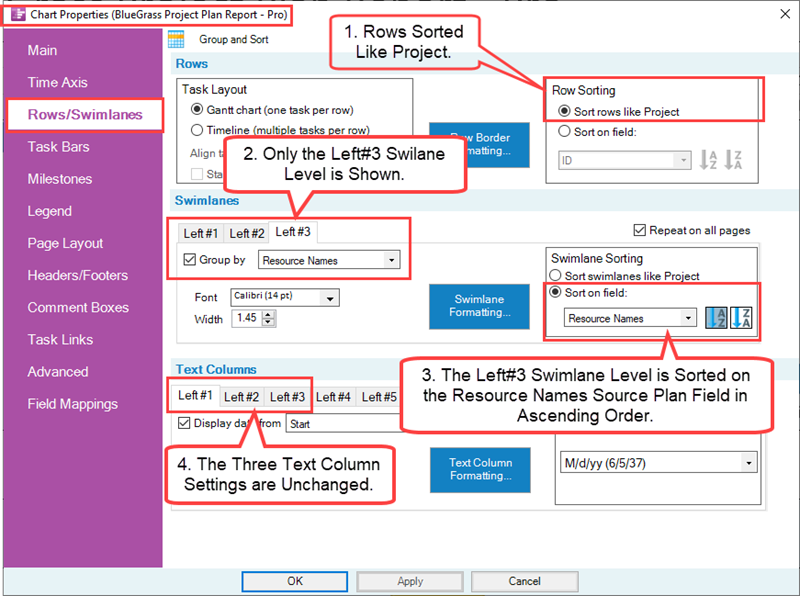
When these settings are applied to the basic chart, the changed chart looks like this:
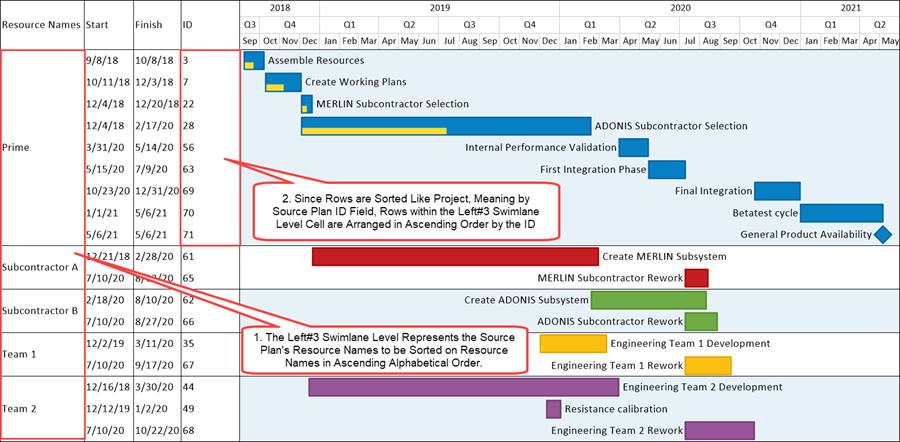
The first result to notice is that the Left#3 swimlane level, based on Resource Names, has five (5) swimlane level cells arranged from top to bottom in alphabetical order. The second result is that each instance of a Resource Names value appears only one time in the set of alphabetically orders Left#3 swimlane level cells. The third result is that within each of the five (5) Left#3 swimlane level cells, the task bars/milestone symbols are collected by ID as specified in the Rows control group of the Chart Properties form’s Rows/Swimlanes tab as Sort rows like Project. The chart groups rows into a single swimlane level such that like Resource Names values are shown together in the chart.
Add the Left#2 Swimlane Level (Sorted Like Project) to Example 1 – Example 2
Extending the first example by adding one more swimlane level, in this case the Left#2 swimlane level, it is possible to see the impact on the chart when the swimlane sorting option is altered. To start off, suppose we add the Left#2 swimlane level to the above chart with the Lefte#2 swimlane level Sorted like Project. The Left#2 swimlane level is based on the Microsoft Project source plan’s Level 1 summary name field values so the change made to the Chart Properties form’s Rows/Swimlanes tab looks like this:
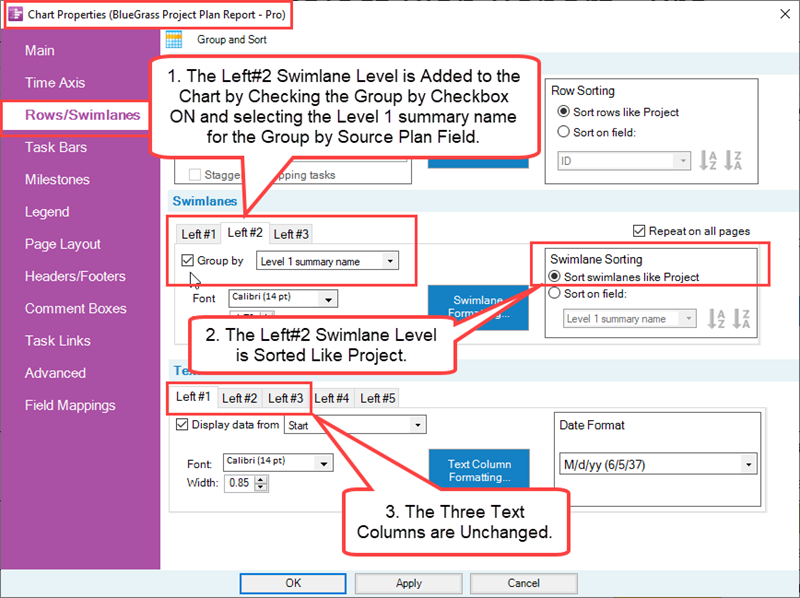
When these setting are applied to the previous chart configuration shown above, the resulting revised chart looks like this:
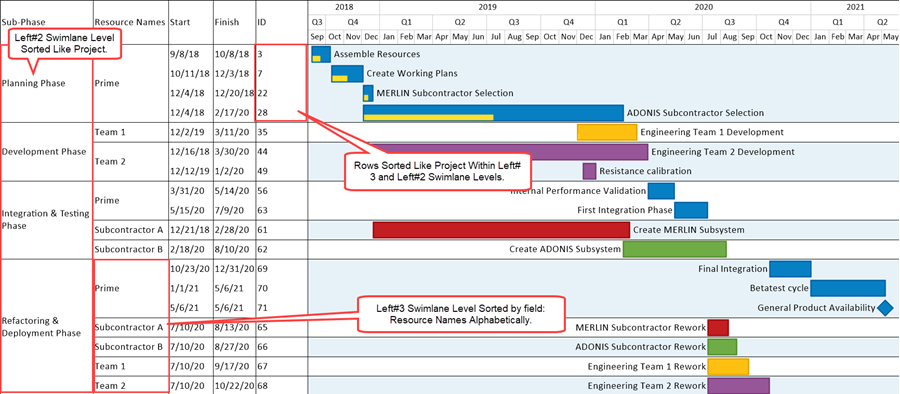
Adding the Left#2 swimlane level sorted like Project changes the configuration of the chart. The Left#2 swimlane level reorganizes its member Left#3 swimlane level cells so they too are configured into the proper positions with respect to the Left#3 swimlane level cells. Within the Left#3 swimlane level cells, these cells are sorted by field: in accordance with each task bars/milestone symbol’s source plan Resource Names field value. This is highlighted in the above illustration where the Refactoring & Deployment Phase Left#2 swimlane level cell has its member Left#3 swimlane level cells sorted in ascending alphabetical order by the Resource Names source plan field values. Finally, rows which are members of each Left#3 swimlane level cells are sorted like Project, that is, by the source plan’s ID field values for each imported task.
If we now go back to the Chart Properties form’s Rows/Swimlanes tab’s Swimlanes control group and change the Swimlane Sorting option for the added Left#2 swimlane level from Sort swimlanes like Project to Sort by field: using the Level 1 summary name source plan field values and sort in ascending order, the changed Chart Properties form looks like this:
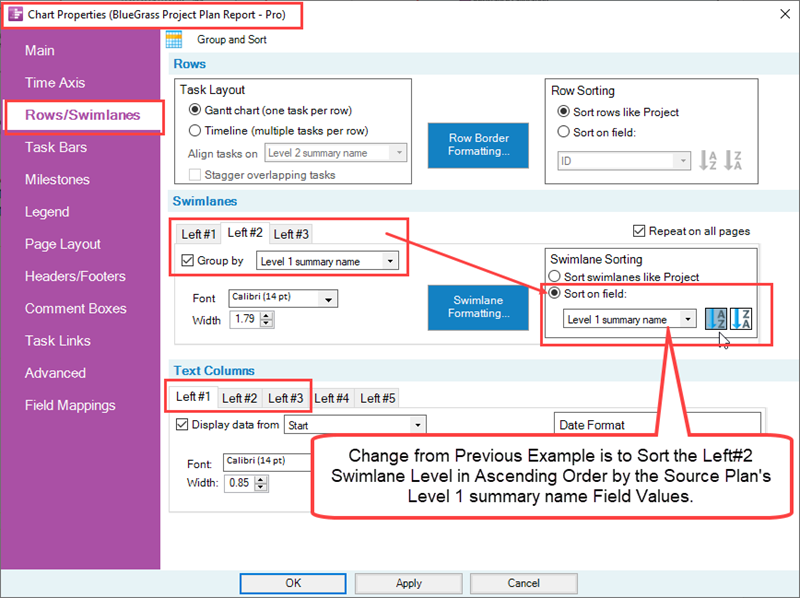
Again, when the setting shown in the form above are applied to the previous chart configuration, the resulting new revised chart looks like this:
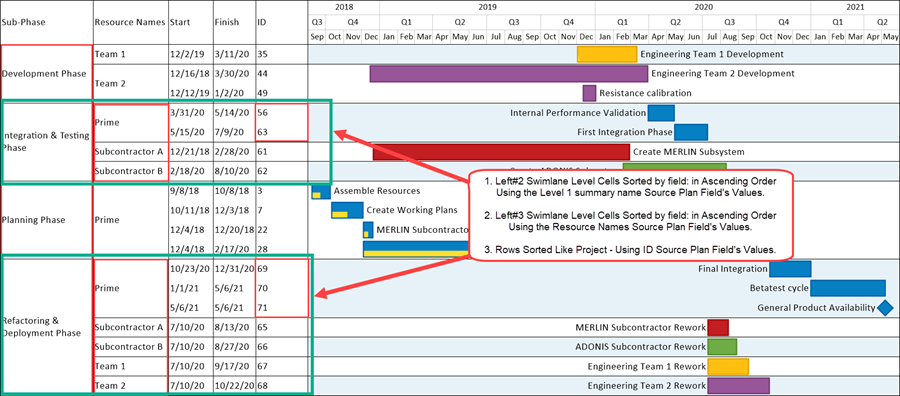
Changing the Left#2 swimlane level’s Swimlane Sort control from Sort swimlanes like Project to Sort by field: using the Level 1 summary name field’s values restructures the Left#2 swimlane level cells in the chart into ascending order from top to bottom. With the Left#3 swimlane level’s Swimlane Sort control set to sort the Left#3 swimlane level cells by Resource Names, the swimlane level cells in the Left#3 swimlane level are reconfigured to keep their membership in their respective Left#2 swimlane level cells as shown above. Finally, within the Left#3 swimlane level, rows continue to be Sorted like Project (i.e., by the source plan’s ID field’s values).
This process can, of course, be continued by adding the Left#1 swimlane level to the chart using the steps covered in the previous two examples.
Formatting Swimlane Level Headings, Cells, and Borders
Swimlane Formatting Sub-Control Group
Each swimlane level tab has a Swimlane Formatting… button that accesses the swimlane level tab’s Swimlane Formatting form provided for each swimlane level as shown below:
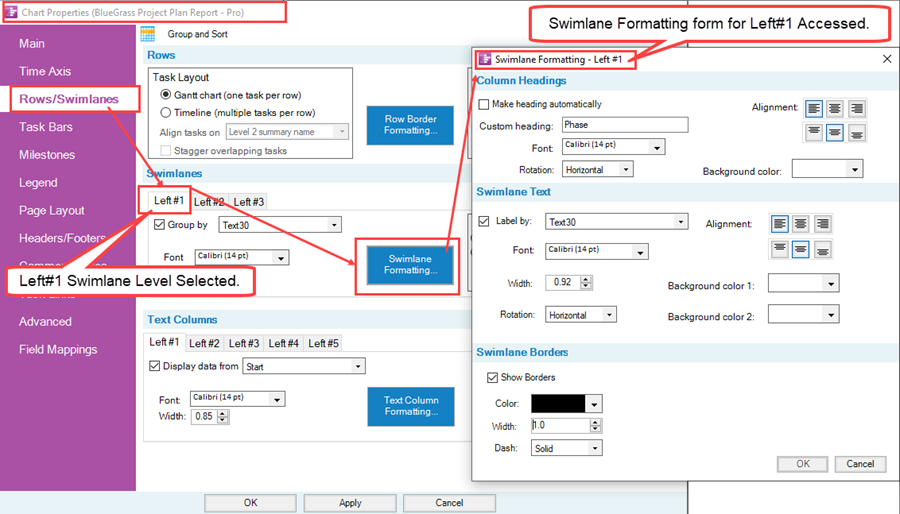
The Swimlane Formatting… button is enabled when the Group by checkbox for the swimlane level is checked ON. Each Swimlane Formatting form has the swimlane level number as part of the title of the form as shown above for the Left#1 swimlane level. The purpose of the three Swimlane Formatting forms is to provide global formatting for all three swimlane level headings and swimlane level cells showing in the chart. The forms also provide controls for managing swimlane borders.
For complete information on the Management of Row and Swimlane Borders, please see the article at: Row and Swimlane Borders
Column Headings Control Group of the Swimlane Formatting Form
The Column Headings control group in the Swimlane Formatting – Left#n form controls:
- The swimlane level heading’s contents
- The alignment of the contents in the swimlane level heading in the Corner cell for the swimlane level
- The Font properties of the contents of the swimlane level heading
- The rotational position of the contents of the swimlane heading
- The Background color of the Corner cell for the swimlane level
Make Heading Automatically Checkbox
OnePager Pro and Express assume that you want to select swimlane level headings for the specific swimlane level as opposed to using the Group by source plan field value specified in the Chart Properties form’s Rows/Swimlanes tab’s Swimlane control group. Accordingly, the Make headings automatically checkbox is checked OFF as the default and the Custom heading window found below the checkbox can be filled in with the desired text string you want to appear in the designated swimlane level heading position as shown here in five (5) steps:
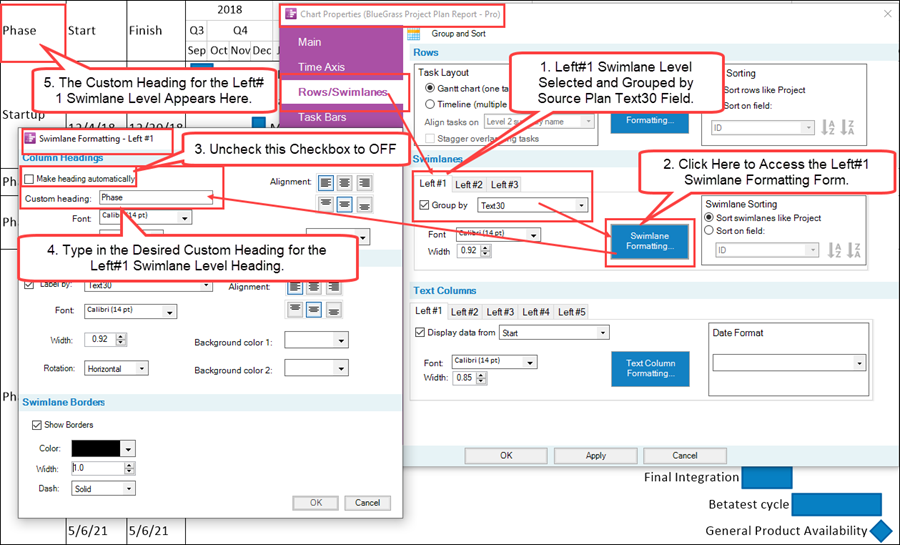
By checking the Make heading automatically checkbox to ON in the Swimlane Formatting form, the Custom heading window is disabled and the Group by source plan field value shown in the Chart Properties form’s Rows/Swimlanes tab’s Swimlanes controls group appears as the swimlane level heading as shown below:
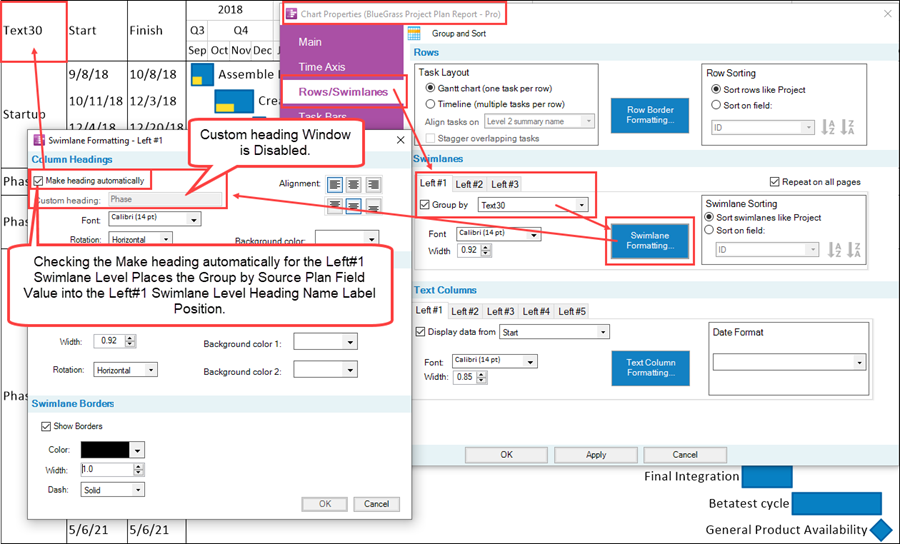
Swimlane Heading Font, Width, Alignment, and Background Color Controls
The remaining controls in the Column Headings control group of the Swimlane Formatting form control global swimlane level heading properties as shown in the section of the form below:
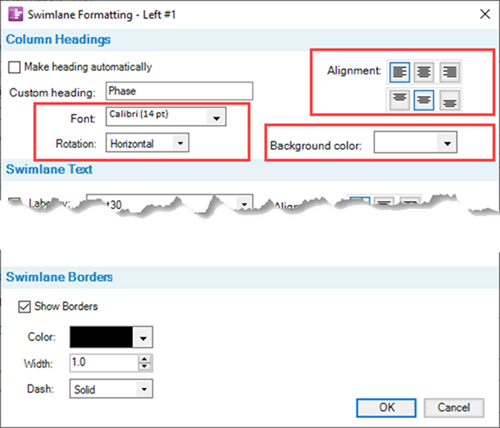
Clicking the Font dropdown button accesses the OnePager standard Font properties form shown here:
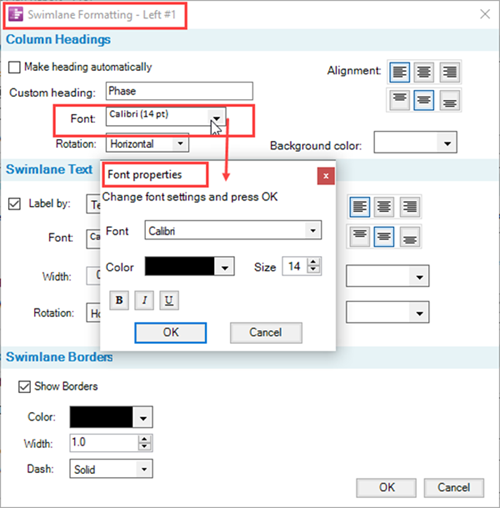
In the Font properties form, clicking the Font dropdown accesses the list of Font styles available on your computer. Clicking the Color dropdown button accesses the OnePager standard Color Chooser form that can be used to change the color of the swimlane level heading. The Size dial selector sets the point size for the swimlane level heading. The three buttons below the Color control allow you to change the swimlane level heading to Bold, Italics, or Underline. The Rotation: control provides a dropdown with three options for rotating the swimlane level heading within its cell. These options include Horizontal, Rotate 90 degrees, and Rotate 270 degrees as shown in the dropdown list below:
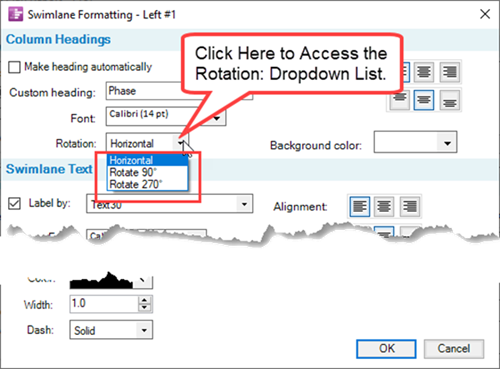
There are six (6) Alignment buttons, three (3) to position the swimlane level heading horizontally in the cell and three (3) to position the swimlane level heading vertically in the cell. The Background color: control dropdown button accesses the OnePager standard Color Chooser form that can be used to change the background color of the selected swimlane level heading cell. The OnePager standard Color Chooser form accessed in this manner looks like this:
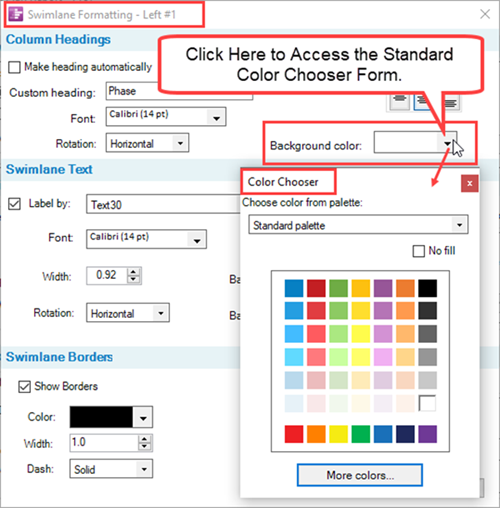
Swimlane Text Control Group of the Swimlane Formatting Form
The Swimlane Text control group in a Swimlane Formatting form provides global formatting controls over the content of the selected swimlane level cells in the selected swimlane level.
The Label by: Checkbox
Within the selected swimlane level (i.e., Left#1, Left#2, and Left#3) the Label by: checkbox must be checked ON for the swimlane level to be shown in the chart. The default setting in any selected swimlane level’s Swimlane Formatting form has the Label by: checkbox checked ON. Turning OFF the Label by: checkbox turns OFF the visibility and influence of the selected swimlane level in the chart. To restore the selected swimlane level to visibility and influence, the Label by: checkbox must be rechecked back to ON. When the Label by: checkbox is checked ON, all the other controls in the Swimlane Text control group are enabled.
Swimlane Text Font, Width, Alignment, and Background Color Controls
All the enabled controls in Swimlane Text control group operate exactly the same as the corresponding controls found in the form’s Swimlane Headings control group. The exception is that the Swimlane Text control group has two (2) Background color controls as shown below as Background color 1: and Background color 2:
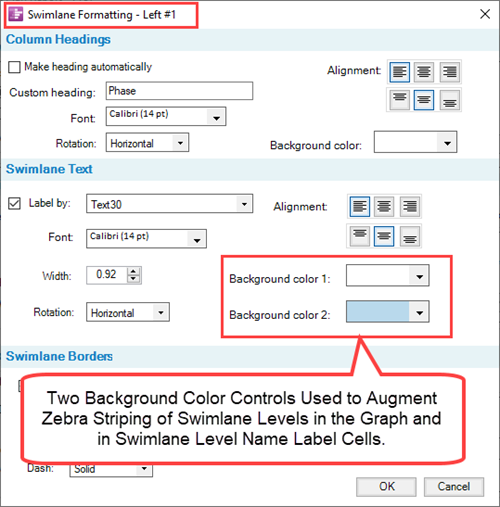
As an illustration of a chart with the Left#1 swimlane level that has Zebra striping in the graph, the above settings for Background color 1: and Background color 2: extend the Zebra striping from the graph area and into the swimlane level cell area as shown here:
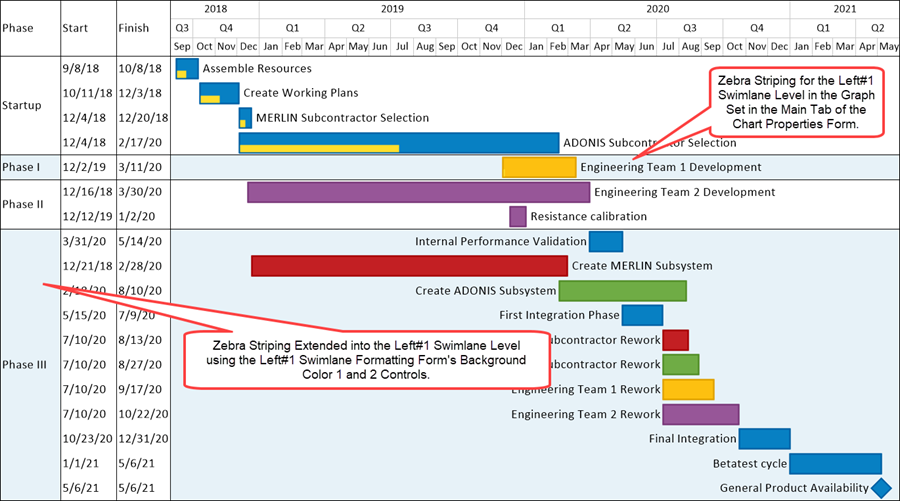
For more detailed information on Zebra Striping in the graph, please see these article at: Zebra Striping for Rows and Swimlanes for OnePager
Swimlane Borders Control Group of the Swimlane Formatting Form
The Swimlane Borders control group in each of the three available Swimlane Formatting form’s controls the look of border lines separating swimlanes and swimlane levels. The Swimlane Borders controls group in the form looks like this:
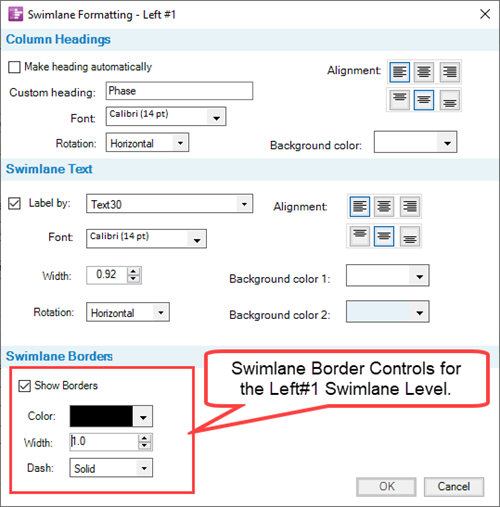
In order for the swimlane level’s borders to show in the chart, the Show Borders checkbox must be checked ON. Unchecking the Show Borders checkbox to OFF hide associated swimlane level borders in the chart. The Color: control dropdown button in this control group accesses the OnePager standard Color Chooser form used to establish the swimlane level’s border color. The Width: dial control establishes the width of the selected swimlane level border in terms of the standard measure established in the Template Properties form (i.e., centimeters or inches). The Dash: dropdown button control accesses a list of standard dash types that include: Solid, Dot, Dash, Dash-dot, and Dash-dot-dot.
Because both rows and swimlanes have borders on top and bottom, it is often likely that the setting used for rows and multiple swimlane levels overlap making the chart possibly difficult to interpret.
Given these complexities, a separate article is provided for discussing these possibilities, providing examples, and suggesting ways for handling these issues. This article can be found at: Row and Swimlane Borders
Using Multiple Swimlane Levels with Timeline Layout Charts
The preceding sections and sub-sections of this article used the Gantt Chart layout as examples related to the use of multiple swimlane levels in OnePager. Multiple swimlane levels can also be applied to the Timeline layout chart when carefully considered in terms of your goals and objectives for supporting schedule presentations. The key to creating Timeline layout charts using multiple swimlane levels is the organization of the tasks in the source plan and the incorporation of useful source plan fields and appropriate data associated with each task.
Sample Timeline Layout Source Plan
As one possible illustration, we created a hypothetical portfolio of programs with embedded projects and tasks associated with each of these embedded projects. We can construct this hypothetical portfolio by structuring the Microsoft Project source plan such that we use the Work Breakdown Structure to create a chart with three (3) swimlane levels to represent the highest levels of the Work Breakdown Structure of interest. Such a Microsoft Project source plan is shown below:
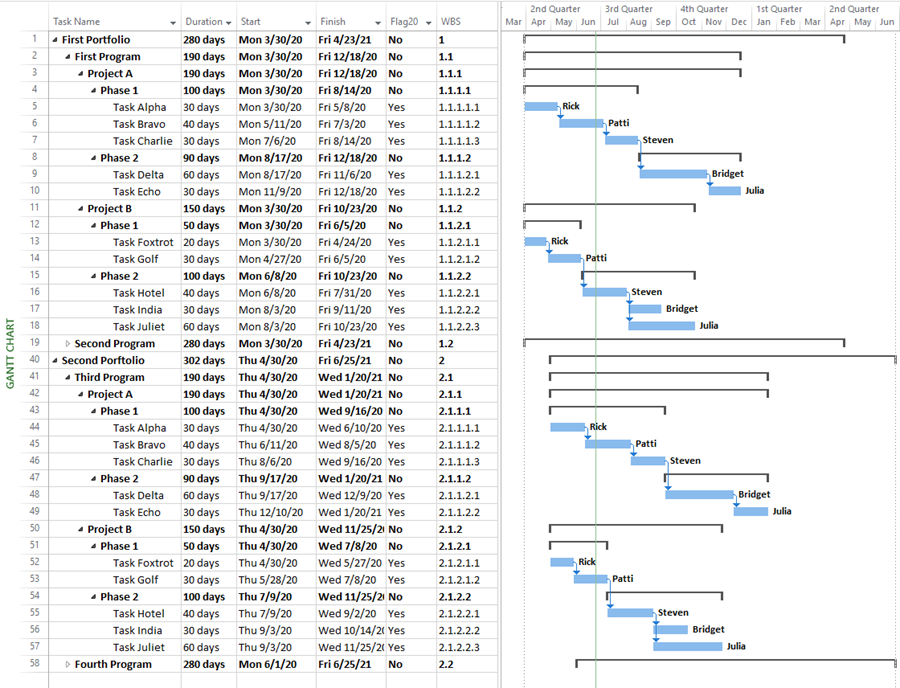
The source plan in the above illustration consists of two Portfolios of two Programs each (not all of which are shown in the source plan to conserve vertical space), two Phases to each Program, and, finally, two or three tasks per Phase. The Flag20 source plan field is used to instruct OnePager on which tasks to import. The source plan’s Work Breakdown Structure (WBS) field is shown in the right-most column consisting from one to five levels. The Microsoft Project timeline is shown on the far right of the illustration above with the tasks and summary tasks above them.
Preparing to Create a Timeline Layout Chart
Our preparation to create a Timeline layout chart is to first select an appropriate OnePager Template Properties form. For this example, the Birds on a Wire Template Properties form is selected to create a Timeline layout chart with potentially multiple swimlane levels. The Rows/Columns tab of the distributed Birds on a Wire Template Properties form is shown below:
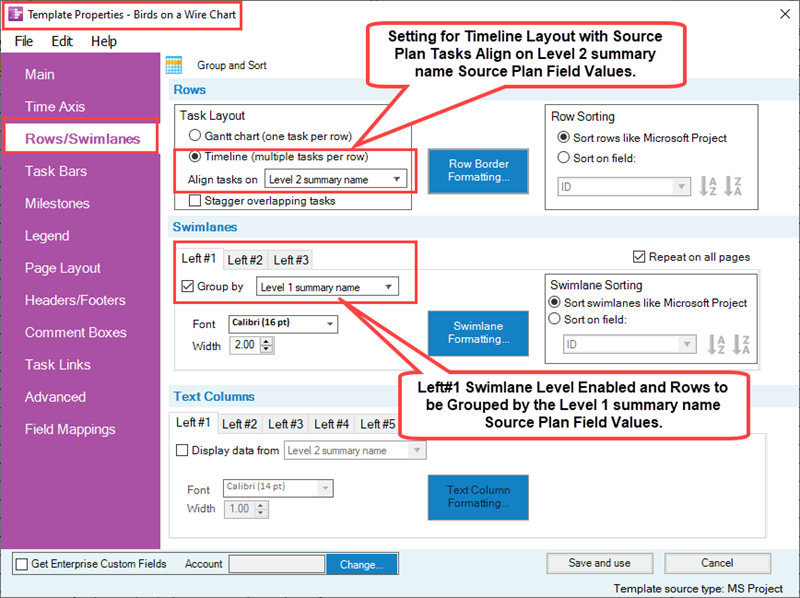
The settings above are preliminary for the purpose of creating the initial Timeline layout chart from which we can use the Chart Properties form’s controls to revise and refine the chart to meet our needs. Once the Template Properties form is determined and set to become the current Template Properties form, we can proceed with the creation of the chart using the standard NEW chart workflow.
For more information on Basic Workflows, please see the articles at: Basic Workflows (Portal)
Creating the Initial Timeline Layout Chart
Following the standard NEW chart workflow steps to create new OnePager chart, we provide a title and other information in the OnePager choices form as shown here:
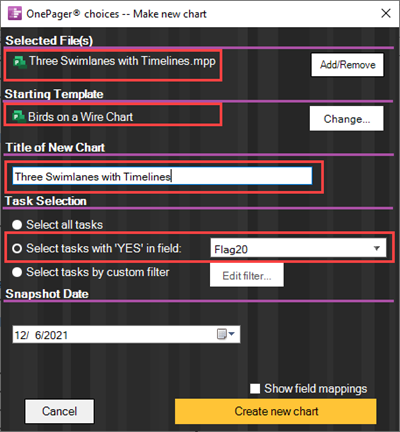
When the Create new chart button is clicked, the initial Timeline layout chart is displayed in the OnePager Chart Editor shown below:

The current Template Properties form (Birds on a Wire) favors displaying task bars as milestone symbols and to enhance readability we’ve take the liberty of turning off the task bar (milestone symbol) name labels in the graph. The milestone symbols are grouped into two rows in each swimlane because the Left#1 swimlane level is Grouped by the Level 1 summary name source plan field values and the task bars/milestone symbols are collected into rows using the Level 2 summary name source plan field values shown above in the Template Properties form’s Rows/Swimlanes tab.
Making Initial Edits to the Timeline Layout Chart
Once we have the initial Timeline layout chart, shown above, we can use the Chart Properties form to make global edits. For example, suppose we change the milestone symbol representation back to task bars and activate the task bar name labels so they show inside the task bars to refine this Timeline layout chart:

After applying the changes made in the Chart Properties form, the above chart shows task bars in ribbon arrangements with the task bar name labels fitting inside the task bars. Inspection of the above chart also shows that some task bars are hidden so we can remedy this situation by clicking the Stagger overlapping tasks checkbox to ON in the Rows control group of the Rows/Swimlanes tab of the Chart Properties form. When this change is made the chart looks like this:
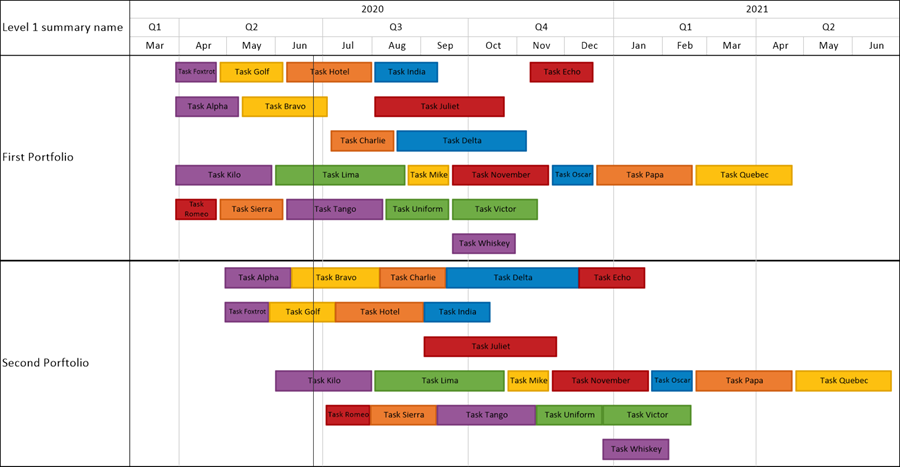
The resulting chart retains its task bar ribbon appearance and by staggering overlapping tasks on the basis of the Level 2 summary name source plan field values alignment, we have solved the problem of hidden task bars due to overlapping start/finish dates.
Adding Swimlane Levels to the Timeline Layout Chart
To carry the example a step further, we can add the Left#2 swimlane level which is based on the Level 2 summary name source plan field values and uncheck the Stagger overlapping tasks checkbox to OFF in all Chart Properties form Rows/Swimlanes tabs as illustrated below:
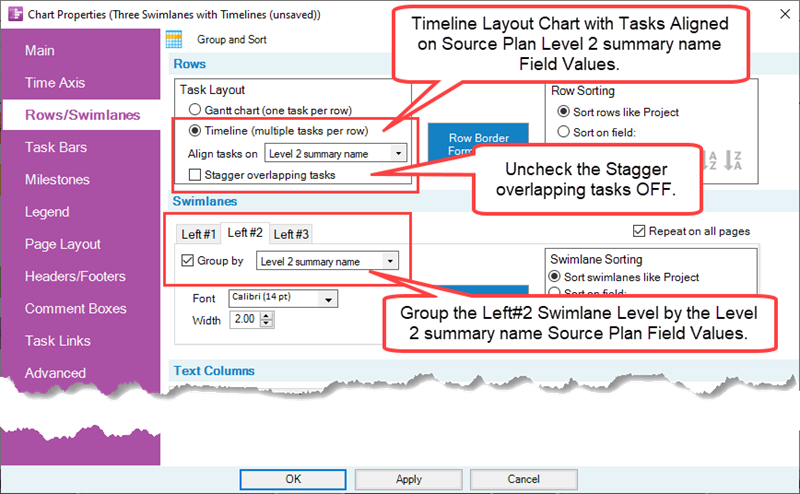
Applying these changes reconfigures the chart to look like this:

The addition of the Left#2 swimlane level is visible showing the four (4) Programs with two (2) Programs in each Portfolio. The number of rows is reduced to one per Left#2 swimlane level and some task bars are overlapping. The overlapping task bars can be remedied by again going to the Rows control group in the Rows/Swimlanes tab of the Chart Properties form and clicking the Stagger overlapping tasks checkbox to ON as is done for the chart reconfiguration shown below:
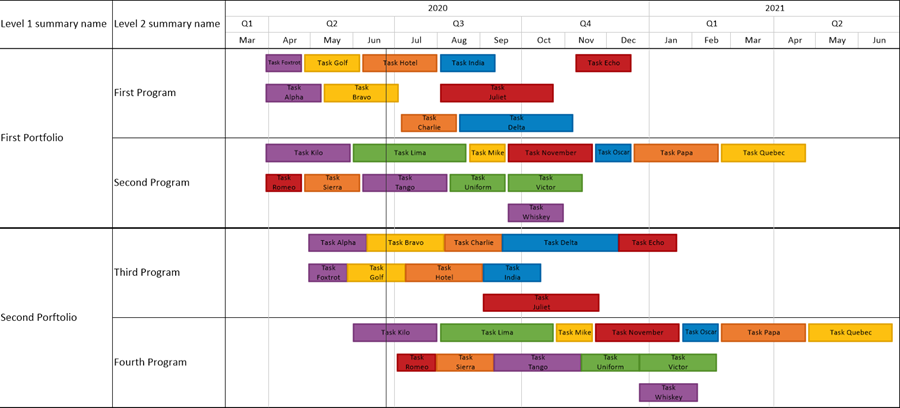
The revised chart above clearly shows all the task bars in each of the four (4) Programs and, for the most part, maintains task bars in the ribbon arrangement. As a final step, if we retain the Stagger overlapping tasks checkbox as checked ON and add the Left#3 swimlane level based on the Level 3 summary name source plan field values, the resulting chart looks like the final chart below:
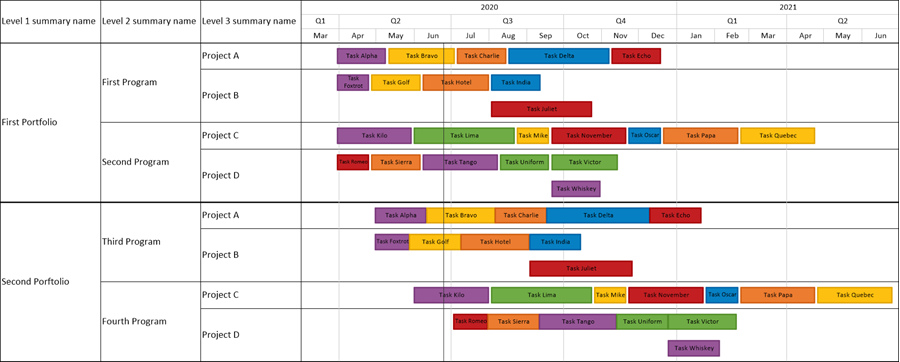
Adding the Left#3 swimlane level representing the individual Projects in each Program of each Portfolio and clearly shows the task bars’ membership in the hierarchy established for this Enterprise. Further, using the Stagger overlapping tasks feature ensures that task bars are not hidden in the chart.
Some Editing Suggestions
It’s easy to see the entire set of three swimlane level cells; however, these take up a lot of horizontal space in the chart because the swimlane level headings are long text strings. These swimlane level headings can be shortened by using the Swimlane Formatting forms for each of the three swimlane levels to change the swimlane level heading’s content to a shorter name as shown below for the Left#1 swimlane level heading:
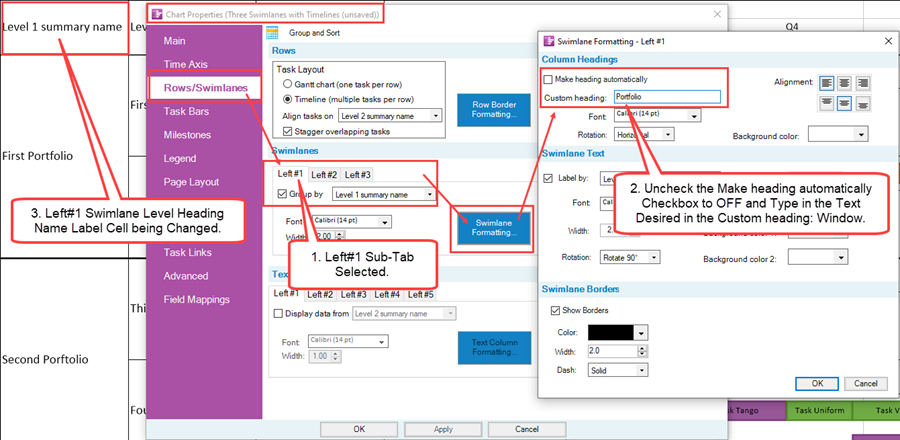
When the setting changes in the Left#1 Swimlane Formatting form are applied, the revised chart looks like this in the Left#1 swimlane level heading:
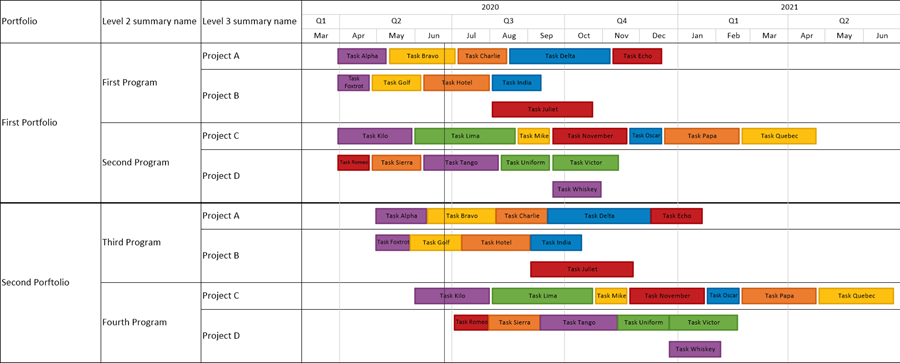
Carrying forward this swimlane level heading editing to the two remaining swimlane level headings, we get the following edited chart:
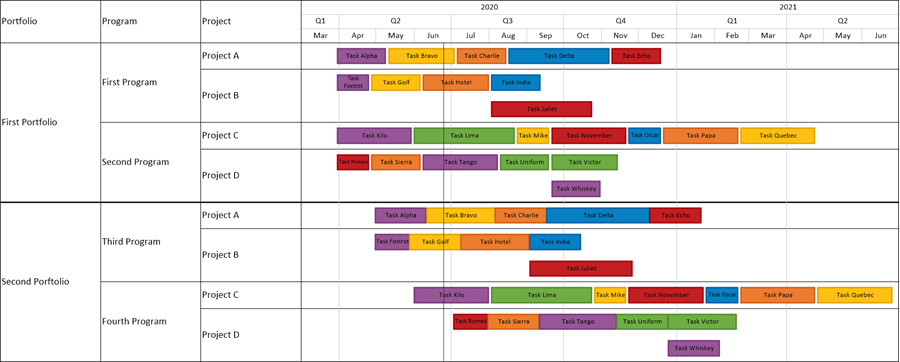
With the three swimlane level heading cells now containing shorter text strings, we can reduce the width of each swimlane level columns by using the controls provided in the individual Swimlane Formatting form’s Width: dial control located in the Swimlane Text control group. As an alternative, we can manually grab the right border of each swimlane level column with the mouse and drag and drop the double-arrow cursor to the left to reduce the width of each swimlane level column as shown in the resulting chart below:
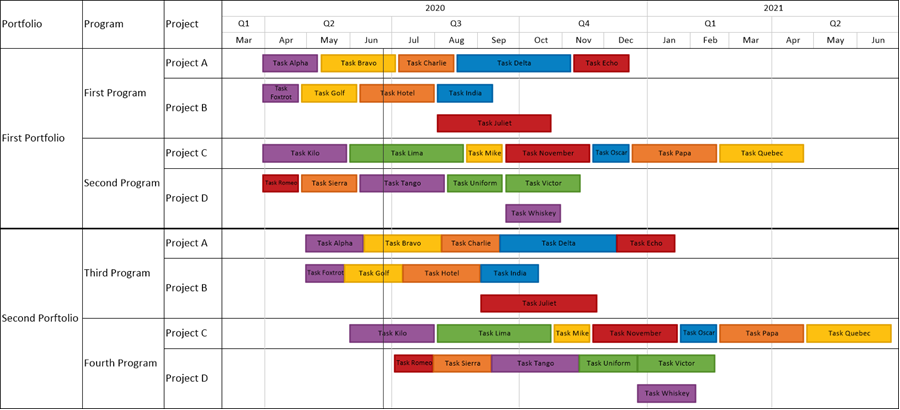
Finally, to add some contrast to the graph, we can Zebra strip the rows in a light color to enhance the chart and make it easier to distinguish between rows as shown below:
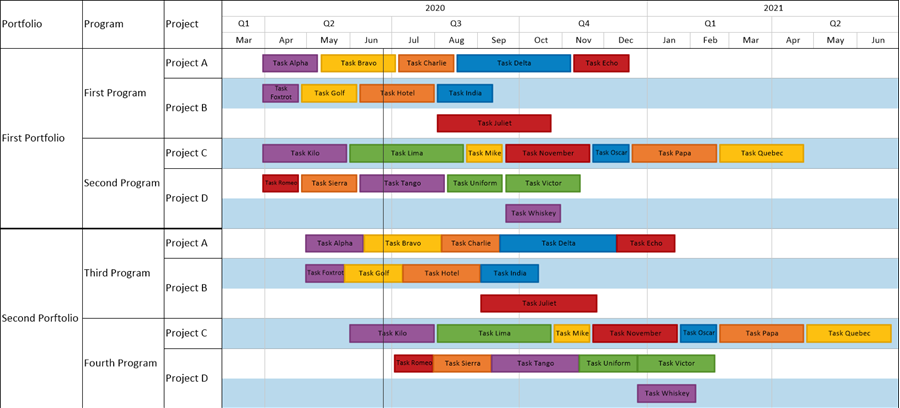
For more detailed information on Zebra Striping in the graph, please see these articles for OnePager Pro and Express, respectively, at: Zebra Striping for Rows and Swimlanes for OnePager
Related Links
Creating Multi-Page Charts (Portal)
Manual Editing Task/Milestone Shapes and Text Labels (Portal)
Creating and Editing Rows and Swimlanes (Portal)
Collecting, Formatting, and Sorting Task/Milestones into Rows
Creating and Formatting Text Columns
Zebra Striping for Rows and Swimlanes for OnePager
Editing with the Chart Properties form (Portal)
Microsoft Project Fields Available to OnePager Pro
Oracle Primavera P6 Columns Available to OnePager
(12.02.1-71)
- Version 7.1
- Charts
- Template Properties Form
- Chart Properties Form
- Ribbon
- Editing a Chart
- OnePager - Tool Bar
- Task/Milestone Editing
- Rows and Swimlanes
- Multiple Swimlane Levels
- Text Columns
- Swimlane Labels
- Row/Swimlane Borders
- Labels
- Name Label Collision Avoidance
- Snapshots
- Snapshot Dependent/Independent
- Row Stripes
- Swimlane Stripes
- Microsoft Project
- Microsoft Excel
- Oracle Primavera P6
- Smartsheet
- OnePager Pro
- OnePager Express
- OnePager Bundle